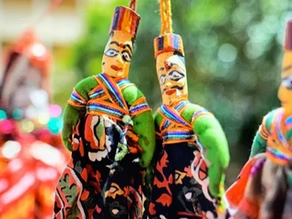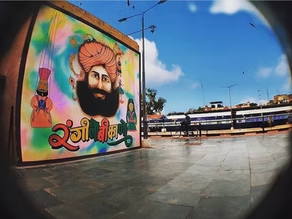RAJASTHAN ON ROAD

THE MESMERIZING ART OF PUPPETRY Ralph Waldo Emerson justly said that “It’s the journey and not the destination”, that matters, so here I take a trip down the memory lane and reminisce about my road trip from The City Of Lakes to The Golden City (Udaipur to Jaisalmer). THE BEGINNING My journey began on a beautiful and cold winter morning, where we all got loaded up in our car, ready to explore the roads while the music and the magnificent Aravali Hills kept us company, while we paved our way out of “Mewar” (the south-central part of Rajasthan). The 490 km long journey was no less than an adventure, as we got a chance to experience the grandeur of the majestic mountains, the spectacular landscapes, and the glowing dunes. After a 5- hour not-so-tiring journey we bid goodbye to the serene views of Mewar and landed in “Marwar” (south-western part of Rajasthan), The word itself means, “The Land of Deserts”. Here, we began our journey to explore the real Rajasthan in its raw form, the state of Marwar, welcoming us with its beautiful colors and prints, which is the essence of Rajasthan. People adorned in beautiful turbans and women with the authentic traditional “lehengas”, left us in awe of them. Read more about travel experience in Rajasthan in the blog written by Sophie THE MUST VISIT STOPS You won’t imagine such a temple exists! While drooling over the amazing culture and heritage of the state we paved our way and reached our first destination, THE BULLET BABA TEMPLE, located about 40kms from Jodhpur. Here, the devotees gather to worship a Royal Enfield Bullet (Motorbike), which is decorated and encased in a glass case. On speaking with the locals here, we got to know that there is a fascinating piece of history associated with this temple. It is said that a local youth, Om Banna died in a motorcycle accident and since then his soul protects people from the same fate. People worship here for a safe journey. Locals also claim that they have seen the ghost of Om Banna! The bike is also believed to have supernatural powers, which intrigued us. I’m not drooling you are!!! After worshipping at the temple, we moved forward and took a stop to enjoy the very famous delicacy of the state, “Kachori“, a seasoned deep-fried bite. It was astounding to watch the oil-dripping kachoris landing directly from the stove on our plates. The burst of flavors in my mouth is something that I will treasure forever. After refreshing ourselves with a blast of flavors, we got back on wheels and moved towards Jodhpur, The capital of the Kingdom Of Marwar, to sink deep into the mysteries, to hear tales of triumphs and battles, to get mixed into the culture and heritage of the city and to surrender to the delicious cuisines the state has to offer. MEHRANGARH FORT (CITADEL OF SUN) Image credits:- Makm Photography on Unsplash) The Sun City We reached Jodhpur at the onset of dusk, where we were welcomed by traditional Rajasthani folk music, which was like a prayer to our ears. The environment was full of soothing lights, bonfires, and melodious tunes. After relaxing in the evening. We started our exploration early next morning, our first destination being the “MEHRANGARH FORT” (Citadel of Sun) which stands on a perpendicular cliff, about 400 feet above the skyline of Jodhpur, is a majestic citadel of colossal proportions. Burnished in red sandstone, the fort presents a strangely haunting yet beautiful view. Walking through the fort and reading the tales of valor made me admire the culture more. The local artists performing at the fort and the beautiful shops added to the beauty of the fort. The fort has an amazing view, which makes me wonder how exciting it would have been to be a king! A little slice of heaven For lunch, we decided to devour the flavors of the city and tried out “Laal Maas”, a mutton curry prepared in a sauce of yogurt and hot spices, along with “Missi Roti”, a Rajasthani bread made of wheat and gram flour. After a sumptuous lunch, we went on to explore the local market, where we enjoyed shopping for souvenirs. For dinner, we enjoyed the famous,” Dhani Dinner”, a village-themed dinner where we enjoyed the local delicacies Kair Sangri, Gatta Curry, Missi Roti, Dal bati churma. The local food was engrossed with a variety of flavors, which played hide and seek with my taste buds. The Golden City After spending the night, we bid goodbye and moved towards the Golden city. A four hour journey which was spent driving through the beautiful roads admiring the beauty of the dunes, we reached our final destination Jaisalmer. JAISALMER FORT (SONAR QILA) We made our first stop at the mesmerizing Jaisalmer Fort, also known as Sonar Qila (Golden Fort). The fort rises from the sand itself and the setting sun adds its magic and shrouds the fort with mystique. It is one of the first living forts of India which has a dwelling of human settlements inside it, giving it a more aesthetic appeal. The fort is adorned with beautiful carvings which depict the culture in a never known way. Ghost Village (Ghost Police on the way!!) We then made our way towards the famous village of Kuldhara, which is also known as the “Ghost Village”, the village is believed to be the home of Paliwal Brahmins, who were forced to leave the village, when they did not submit to the wishes of Salim Ali, who was a powerful prime minister of the state. But, it is believed that the Paliwals cursed the village such that nobody would be able to settle there and to date, the village remains barren. The walls of the houses here depict a story of pain and sadness. The village tells the tales of a struggle adding to the history
Ultimate Guide to Bikaner

Rangeelo Bikano by @bikanercityblog on Instagram In the northwestern part of the desert state of India, lies the princely and colorful district of Bikaner. Named after its founder Rao Bikaji, Bikaner is known for generating some of the world’s best camels, consequently earning its nickname of ‘camel country’. When you hear the name of this city what is the first thing that comes to your mind? Probably Bikaneri Bhujiya right! But did you know that Bikaner is home to one of the only 2 models of biplane used by British during the World War I, presented by the British to Maharaja Ganga Singh, the ruler of the time? Likewise, many such unique factors as a temple of rats make Bikaner the fourth-largest city of Rajasthan. HISTORY OF BIKANER Portrait of Rao Bikaji by @narendra.bhawan.bikaner The ancestries of Bikaner can be traced back to the Rathore prince, Rao Bikaji, who established the kingdom of Bikaner back in 1488. Bikaji was one of Rao Jodhaji’s five sons, the renowned founder of Jodhpur. According to the Legend, Bikaji left his father’s Durbar in resentment after an unkind remark from his father and wandered far when he came upon the wilderness called Jangladesh where he decided to set up his kingdom and converted it into an extraordinary and stunning city now called Bikaner. HOW TO REACH? Bikaner is placed 330 kilometers northwest of the state capital, Jaipur. Bikaner city is the administrative headquarters of Bikaner District and Bikaner division. By Road:- Bikaner is well fulfilled with roads and buses are easily available. There are direct routes to major cities of India and Rajasthan like Delhi, Jaipur, Agra, Sri Ganganagar, Jodhpur, Alwar, Rewari, Narnaul, Ludhiana, Bhatinda, Ambala, Panipat, Surat, Ahmedabad, Ajmer, Haridwar, Jaisalmer, and many other cities. By Train:- Bikaner railway station is an important railway junction in the North Western Railway zone of Indian Railways. Today Bikaner Railway Station is efficiently well connected to National Capital Delhi and Rajasthan State’s capital Jaipur along with major Indian cities like Jodhpur, Kolkata, Mumbai, Kanpur, Agra, Allahabad, Surat, Ahmedabad, Vadodara, Pathankot, Amritsar, Haridwar, Jammu, Chandigarh, Pune, Bengaluru, Chennai, Hyderabad, Guwahati, Puri, Coimbatore, Thiruvananthapuram, Bhubaneswar, Indore, Jalandhar, etc. By Air:- Bikaner has a Domestic Civil Airport which is located 15 km west of the city. Regular flights to Jaipur and Delhi commenced in 2017-18. BEST TIME TO VISIT Bikaner is situated in Rajasthan a desert state, where the climate is of the extreme type therefore summers are extremely hot and winters are extremely cold. Hence the best time to visit Bikaner is during January and March and October and December. During this time the weather is breezy, pleasant, and a bit chill. THINGS TO LOOK OUT FOR:- Forts and Palaces 1. Junagarh Fort and Prachina Museum Picteresque Junagarh Fort by @narendra.bhawan.bikaner on Instagram Junagarh is a very distinctive fort. Its unique features, like being one of the few major forts in Rajasthan which is not built on a hilltop, make it stand out from all the other forts. Junagarh is also known for being an impenetrable fortress that holds the significance of having never been seized. It was constructed in 1588 AD by Raja Rai Singh, one of Emperor Akbar’s most prominent generals. The fort houses some gorgeous courtyards, balconies, jharokhas, and palaces beautifully designed in red sandstone and marble making it one of the best places to visit in Bikaner. Fun fact: Bollywood movie Manikarnika: The Queen of Jhansi and Nayak were shot at Junagarh Fort. In 1961, Maharaja Karni Singh set up a museum within the fortress that displays royal clothing, essences, accessories of Rajasthani majesty, cutlery, and portraits of the royalty. The ‘Poshaks’ which are the garments worn by Rajput ladies and the family portraits are a constant reminder of the fact that heritage and culture are slowly fading away. The craft of conventional designs, styles, and threadwork on exhibit conveys the fact that Bikaneri culture is so dynamic and vibrant. 2. Laxmi Niwas Palace Laxmi Niwas Palace Laxmi Niwas Palace was the dwelling of the king of Bikaner, Maharaja Ganga Singh. Constructed between 1898 and 1902 by British architect Sir Samuel Swinton Jacob, this building showcases an Indo-Saracenic architectural character. It is now converted into a luxury hotel that is owned by the Royal Family of Bikaner. Fun Fact: The Palace was portrayed as the gorgeous royal residence of Fawad Khan in the Bollywood movie Khoobsurat and was also used for shooting another Bollywood movie Baadshaho. 3. Lalgarh Palace Lalgarh Palace by @narendra.bhawan.bikaner on Instagram The construction of this lavish and imperial palace was initiated by Maharaja Ganga Singh in 1902 in remembrance of his late father Maharaja Lal Singh. The palace’s architectural marvel was brought to life by Sir Swinton Jacob, who cultivated this fantasy palace by stirring Rajput, Islamic, and European architecture. Fun Fact: Dum Dum song from the Bollywood movie Band Baja Baraat was shot at this palace. 4. Gajner Palace and Lake Gajner Palace with evening lights Gajner Palace is often nicknamed as an unrivaled gem of the Thar. Maharaja Gaj Singh of Bikaner laid the foundation for Gajner Palace in the year 1784 which was then finished off by the eminent Maharaja Ganga Singh of Bikaner on the banks of the lake. Covering vast lands of 6000 acres this palace has dramatic landscape, picturesque and architectural beauty. The palace is surrounded by forest and thus was meant to satisfy as a hunting and comfortable vacation residence for the royalty and visiting guests. It has now been transformed into a Heritage Hotel. Fun Fact: Bollywood movie Anamika was shot at this Palace. Sunset at the Gajner Lake Temples 1. Karni Mata Temple Entrance of Karni Mata Temple by @deshnoke_darbar_jai_maa_karni on Instagram The Karni Mata Temple at Deshnok is considered the

